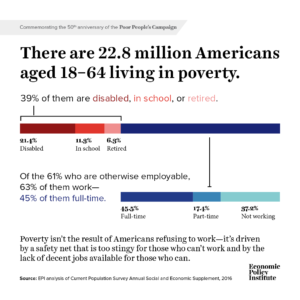The EPI article, 50 years after the Poor People’s Campaign poverty persists because of a stingy safety net and a dysfunctional labor market by Elise Gould and Jessica Schieder (5/24/2018), answers the question with a graph (reposted here) and this:
The bottom bar shows us that, among those working-age individuals who are otherwise employable, 63 percent are working and 45.5 percent are working full time. An additional 37.2 percent are not working, but this share includes 1.6 million people living below the poverty line who are actively seeking a job. The data make it clear that millions of people who are active participants in the labor market are unable to make ends meet, either due to insufficient hours or low wages.









